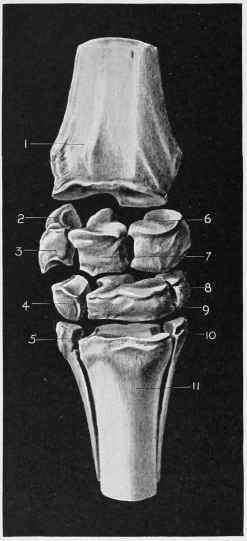Carpus Or Knee
Description
This section is from the book "The Horse - Its Treatment In Health And Disease", by J. Wortley Axe. Also available from Amazon: The Horse. Its Treatment In Health And Disease.
Carpus Or Knee
This (fig. 301) is the analogue of the wrist of man. It is made up of seven, sometimes eight, small irregular bones arranged in two rows of three each, one resting upon the other, with the seventh bone (pisiform) situated at the posterior and outer part of the upper row.

Fig. 301. - Carpus.
1 Radius. 2 Pisiform. 3 Cuneiform. 4 Unciform. 6 Outer Small Metacarpal Bone. 6 Scaphoid. 7 Lunar. 8 Trapezoid. 9 Os Magnum. 10 Inner Small Metacarpal Bone. 11 Large Metacarpal Bone.
The bones of the upper row, enumerating them from within outward, are the scaphoid, lunar, cuneiform, and the pisiform behind; those of the lower row are the trapezoid, magnum, and unciform. Sometimes a fourth, termed the trapezium, is found at the inner and posterior part of the lower row.
All these bones are united by short strong ligaments. At their several points of contact they are covered with articular cartilage or gristle, and enclosed in a synovial capsule. Altogether the knee is admirably adapted, by its many parts, to diffuse and disperse concussion, and at the same time for the performance of that high and free action so much admired by connoisseurs.
Continue to:


